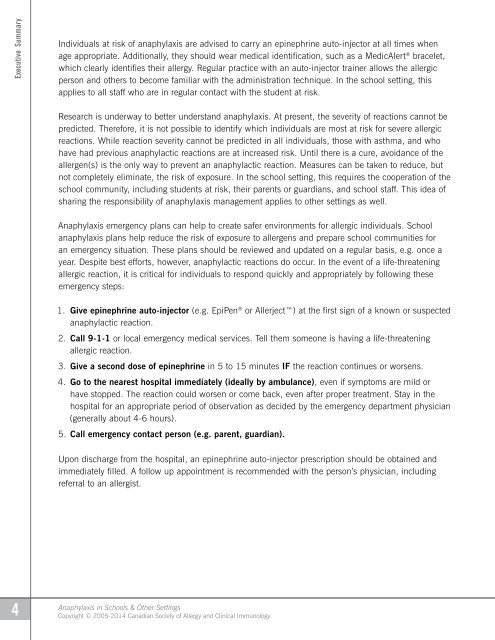Anaphylaxis in Schools 3rd Edition
Anaphylaxis in Schools 3rd Edition
Anaphylaxis in Schools 3rd Edition
Create successful ePaper yourself
Turn your PDF publications into a flip-book with our unique Google optimized e-Paper software.
Executive Summary<br />
Individuals at risk of anaphylaxis are advised to carry an ep<strong>in</strong>ephr<strong>in</strong>e auto-<strong>in</strong>jector at all times when<br />
age appropriate. Additionally, they should wear medical identification, such as a MedicAlert ® bracelet,<br />
which clearly identifies their allergy. Regular practice with an auto-<strong>in</strong>jector tra<strong>in</strong>er allows the allergic<br />
person and others to become familiar with the adm<strong>in</strong>istration technique. In the school sett<strong>in</strong>g, this<br />
applies to all staff who are <strong>in</strong> regular contact with the student at risk.<br />
Research is underway to better understand anaphylaxis. At present, the severity of reactions cannot be<br />
predicted. Therefore, it is not possible to identify which <strong>in</strong>dividuals are most at risk for severe allergic<br />
reactions. While reaction severity cannot be predicted <strong>in</strong> all <strong>in</strong>dividuals, those with asthma, and who<br />
have had previous anaphylactic reactions are at <strong>in</strong>creased risk. Until there is a cure, avoidance of the<br />
allergen(s) is the only way to prevent an anaphylactic reaction. Measures can be taken to reduce, but<br />
not completely elim<strong>in</strong>ate, the risk of exposure. In the school sett<strong>in</strong>g, this requires the cooperation of the<br />
school community, <strong>in</strong>clud<strong>in</strong>g students at risk, their parents or guardians, and school staff. This idea of<br />
shar<strong>in</strong>g the responsibility of anaphylaxis management applies to other sett<strong>in</strong>gs as well.<br />
<strong>Anaphylaxis</strong> emergency plans can help to create safer environments for allergic <strong>in</strong>dividuals. School<br />
anaphylaxis plans help reduce the risk of exposure to allergens and prepare school communities for<br />
an emergency situation. These plans should be reviewed and updated on a regular basis, e.g. once a<br />
year. Despite best efforts, however, anaphylactic reactions do occur. In the event of a life-threaten<strong>in</strong>g<br />
allergic reaction, it is critical for <strong>in</strong>dividuals to respond quickly and appropriately by follow<strong>in</strong>g these<br />
emergency steps:<br />
1. Give ep<strong>in</strong>ephr<strong>in</strong>e auto-<strong>in</strong>jector (e.g. EpiPen ® or Allerject) at the first sign of a known or suspected<br />
anaphylactic reaction.<br />
2. Call 9-1-1 or local emergency medical services. Tell them someone is hav<strong>in</strong>g a life-threaten<strong>in</strong>g<br />
allergic reaction.<br />
3. Give a second dose of ep<strong>in</strong>ephr<strong>in</strong>e <strong>in</strong> 5 to 15 m<strong>in</strong>utes IF the reaction cont<strong>in</strong>ues or worsens.<br />
4. Go to the nearest hospital immediately (ideally by ambulance), even if symptoms are mild or<br />
have stopped. The reaction could worsen or come back, even after proper treatment. Stay <strong>in</strong> the<br />
hospital for an appropriate period of observation as decided by the emergency department physician<br />
(generally about 4-6 hours).<br />
5. Call emergency contact person (e.g. parent, guardian).<br />
Upon discharge from the hospital, an ep<strong>in</strong>ephr<strong>in</strong>e auto-<strong>in</strong>jector prescription should be obta<strong>in</strong>ed and<br />
immediately filled. A follow up appo<strong>in</strong>tment is recommended with the person’s physician, <strong>in</strong>clud<strong>in</strong>g<br />
referral to an allergist.<br />
4<br />
<strong>Anaphylaxis</strong> <strong>in</strong> <strong>Schools</strong> & Other Sett<strong>in</strong>gs<br />
Copyright © 2005-2014 Canadian Society of Allergy and Cl<strong>in</strong>ical Immunology


